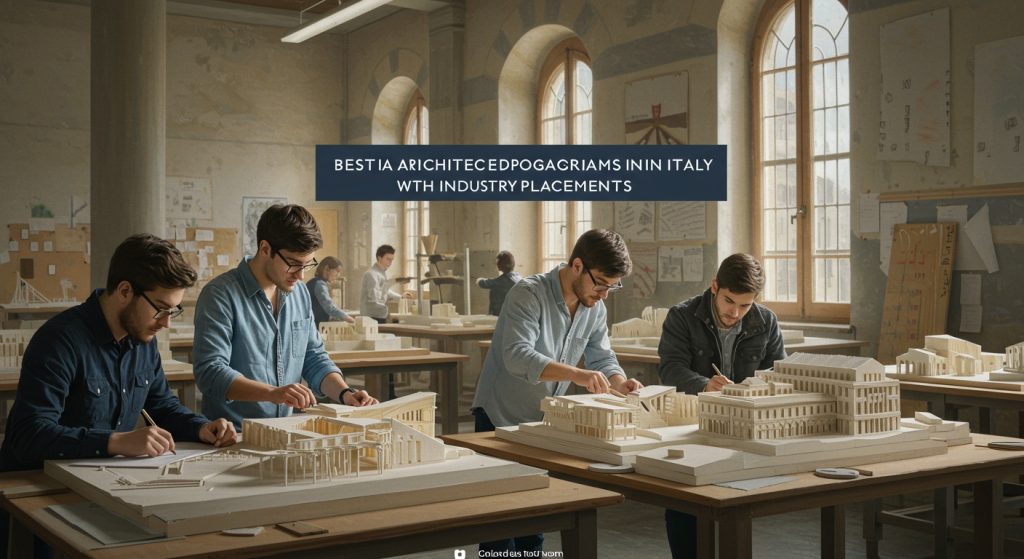Italy, a living museum of architectural innovation from Roman aqueducts to Renaissance cathedrals, now faces the challenge of training the next generation of architects to address contemporary urban complexities. The best architecture programs in Italy don’t just teach theory; they actively immerse students in the professional world through robust industry placements. These placements are crucial, enabling students to apply parametric design principles in real-world restoration projects, contribute to sustainable building initiatives that address climate change. Interpret the intricacies of navigating Italian building codes on historical sites. The focus on practical experience allows graduates to seamlessly transition into leading architectural firms, equipped not just with knowledge. With demonstrable skills and industry connections.
Understanding the Landscape of Architecture Education in Italy
Italy, renowned for its rich architectural heritage from the Roman Empire to the Renaissance, offers a unique setting for studying architecture. Architecture programs in Italy are deeply rooted in history and theory while also embracing contemporary design and technology. These programs often emphasize hands-on experience and critical thinking, preparing graduates for diverse roles in the field. Industry placements, or internships, are a crucial component, providing students with practical skills and professional connections.
Key Elements of a Quality Architecture Program
When evaluating architecture programs, several factors distinguish the best from the rest:
- Curriculum Depth and Breadth: The curriculum should cover a comprehensive range of topics, including architectural history, design principles, structural engineering, sustainable design, urban planning. Digital modeling.
- Faculty Expertise: A strong faculty comprised of experienced architects, researchers. Educators is essential. They should be actively involved in the profession and able to provide students with valuable insights and mentorship.
- Studio Culture: Architecture education relies heavily on studio work, where students develop their design skills through hands-on projects and critiques. A vibrant and supportive studio culture is crucial for fostering creativity and collaboration.
- Industry Connections: Strong relationships with architectural firms, construction companies. Other industry partners are vital for providing students with internship opportunities and networking possibilities.
- International Exposure: Opportunities for studying abroad, participating in international workshops. Collaborating with students from other countries can broaden students’ perspectives and enhance their global competitiveness.
- Facilities and Resources: Access to well-equipped studios, workshops, digital fabrication labs. Libraries is essential for supporting students’ learning and research.
The Significance of Industry Placements (Internships)
Industry placements, often referred to as internships or practical training, are integral to architecture education. They provide students with invaluable opportunities to:
- Apply Theoretical Knowledge: Internships allow students to apply the concepts and skills they have learned in the classroom to real-world projects.
- Develop Practical Skills: Students gain hands-on experience in design development, construction documentation, project management. Client communication.
- Build Professional Networks: Internships provide students with opportunities to connect with architects, engineers. Other industry professionals, building valuable networks for future employment.
- Gain a Competitive Edge: Students with internship experience are more attractive to employers and have a higher chance of securing employment after graduation.
- Explore Career Paths: Internships allow students to explore different areas of architecture and identify their interests and strengths.
Top Architecture Programs in Italy with Industry Placements
While a definitive ranking can be subjective, several Italian universities are consistently recognized for their strong architecture programs and industry connections. Here are some notable examples:
- Politecnico di Milano: One of the most prestigious technical universities in Italy, Politecnico di Milano offers a range of architecture programs at the bachelor’s and master’s levels. The university has strong ties with leading architectural firms in Italy and internationally, providing students with numerous internship opportunities. The programs often integrate collaborative projects with companies, offering a direct bridge to the professional world.
- Politecnico di Torino: Another top-ranked technical university, Politecnico di Torino, is known for its focus on innovation and sustainability in architecture. The university’s architecture programs emphasize hands-on learning and research. It has partnerships with various companies and organizations that offer internship opportunities to students.
- IUAV University of Venice: Situated in the heart of Venice, IUAV is a specialized architecture university with a strong emphasis on design theory and practice. The university has a long history of producing renowned architects. Its programs offer a unique blend of historical and contemporary perspectives. IUAV provides support for students seeking internships, leveraging its location within a culturally rich and architecturally significant city.
- University of Florence: The University of Florence’s architecture program is renowned for its focus on restoration and preservation, reflecting the city’s rich cultural heritage. The program provides students with opportunities to work on real-world projects, including the restoration of historic buildings, giving them invaluable practical experience. The university actively facilitates internships with local and national heritage organizations.
- University of Rome “La Sapienza”: As one of the oldest and largest universities in Europe, La Sapienza offers a comprehensive architecture program covering a wide range of specializations. The university has strong research capabilities and provides students with opportunities to participate in cutting-edge research projects. The Career Service department helps students to find relevant industry placements.
Comparing Program Features: A Snapshot
To help you compare these programs, here’s a simplified table highlighting key features:
| University | Program Strengths | Industry Connections | Location Advantages |
|---|---|---|---|
| Politecnico di Milano | Comprehensive curriculum, strong research focus | Extensive network with leading firms | Milan: Hub for design and innovation |
| Politecnico di Torino | Emphasis on sustainability and innovation | Partnerships with various companies and organizations | Turin: Industrial and technological center |
| IUAV University of Venice | Design theory and practice, historical perspective | Located in a culturally rich city | Venice: Architectural heritage and artistic inspiration |
| University of Florence | Restoration and preservation, cultural heritage | Real-world restoration projects, heritage organizations | Florence: Renaissance architecture and art |
| University of Rome “La Sapienza” | Comprehensive program, strong research | Career Service department support | Rome: Historical and political center |
The Application Process and Requirements
Applying to architecture programs in Italy typically involves submitting an application form, academic transcripts, a portfolio of design work. A statement of purpose. Some universities may also require an entrance exam or interview.
- Portfolio: The portfolio is a crucial component of the application, showcasing your design skills, creativity. Technical abilities. It should include a selection of your best work, such as drawings, models. Digital renderings.
- Statement of Purpose: The statement of purpose is your opportunity to explain why you are interested in studying architecture and what you hope to achieve through your studies. It should demonstrate your passion for the field and your understanding of the challenges and opportunities it presents.
- Language Proficiency: Most programs are taught in Italian, so international students will need to demonstrate proficiency in the language. Some programs may also offer courses in English.
Navigating Industry Placements: Tips for Success
Securing a valuable industry placement requires proactive effort and strategic planning:
- Start Early: Begin your search for internships well in advance of the placement period. Research companies and organizations that align with your interests and skills.
- Network: Attend industry events, career fairs. Networking sessions to connect with architects and other professionals.
- Prepare a Strong Resume and Portfolio: Your resume and portfolio are your marketing tools. Make sure they are well-organized, visually appealing. Tailored to the specific requirements of each internship opportunity.
- Seek Guidance from Your University: Your university’s career services department can provide valuable resources and support, including resume workshops, interview preparation. Access to internship databases.
- Be Proactive and Persistent: Don’t be afraid to reach out to companies directly and express your interest in an internship. Follow up on your applications and be persistent in your pursuit.
Choosing the right architecture program is a significant investment in your future. Programs like those at the affordable engineering colleges in India can offer similar experiences. By carefully considering your interests, goals. The specific features of each program, you can find the ideal fit and launch a successful career in architecture.
Conclusion
The journey to becoming a successful architect in Italy, enhanced by invaluable industry placements, hinges on embracing continuous learning and practical application. As the architecture landscape evolves with sustainable design becoming paramount. Innovative technologies like BIM transforming workflows, your ability to adapt will be your greatest asset. Think beyond the classroom; seek out mentors, network actively within the Italian architectural community. Immerse yourself in the rich cultural heritage that inspires so much of Italy’s design. Success in this field isn’t just about technical prowess; it’s about vision, collaboration. A deep understanding of how architecture shapes the human experience. Embrace the challenges, learn from every placement. Build a portfolio that speaks to your unique talent and passion. The future of Italian architecture awaits your contribution.
FAQs
So, what’s the deal with finding architecture programs in Italy that actually offer industry placements? Are they common?
Okay, so you’re thinking about getting your hands dirty while studying architecture in Italy, which is smart! While not every program has a built-in industry placement, they’re definitely out there. You’ll need to look closely at program descriptions and sometimes dig a little deeper on university websites or contact the faculty directly to confirm. Think of it like finding hidden gems – they exist. Require a bit of searching.
What are the main benefits of doing an industry placement during my architecture studies in Italy, besides, you know, getting experience?
Beyond just the experience, which is HUGE, industry placements in Italy offer a ton. You’ll get a real-world understanding of Italian architectural practices, network with professionals (potential future employers!). Learn about building codes and regulations specific to Italy. Plus, you’ll boost your resume and stand out from the crowd after graduation. It’s a fast track to becoming a well-rounded architect.
Which cities in Italy are known for having strong architecture programs and good opportunities for industry placements?
Good question! Milan is a big one – it’s a design and fashion hub, so there are lots of architectural firms. Venice, with its unique urban challenges, also offers interesting placement possibilities. Rome, Florence. Turin are worth considering too, as they have established architecture schools and vibrant design scenes. It really depends on what kind of architecture you’re most interested in.
How long do these industry placements usually last?
The duration can vary quite a bit. Some might be short internships lasting a few weeks during the summer break, while others are semester-long placements integrated into the curriculum. It’s really program-dependent, so check the details carefully!
Okay. What kind of tasks would I actually be doing during an industry placement? Am I just going to be making coffee?
Hopefully not just coffee! While some administrative tasks might be involved, a good placement will give you opportunities to assist with design development, create drawings and models, participate in site visits. Maybe even contribute to presentations. It’s all about learning the ropes and getting involved in real projects.
Is it necessary to speak Italian fluently to get a good industry placement in Italy?
While it’s not always a strict requirement, knowing Italian will definitely open more doors and make your experience much richer. Think about it: you’ll be communicating with colleagues, clients. Contractors. Even a basic understanding will be a huge asset. Plus, immersing yourself in the language is part of the fun of studying abroad!
Any tips for actually landing one of these industry placements?
Start early! Network with professors, attend career fairs. Research architectural firms you’re interested in. Tailor your resume and cover letter to each specific opportunity, highlighting your skills and experience. And don’t be afraid to reach out to firms directly, even if they don’t have advertised internships. Show enthusiasm and a genuine interest in their work – that goes a long way!

